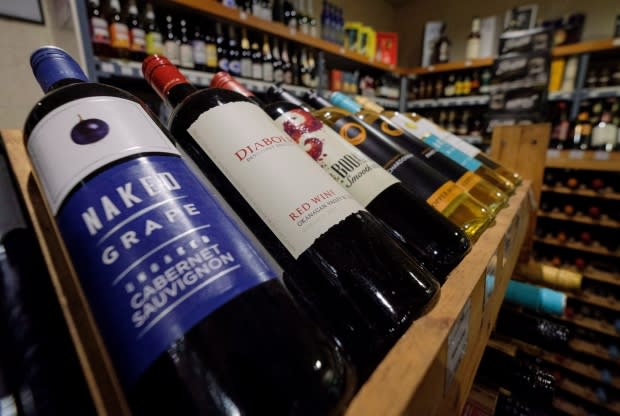Same wine, different tastes: Study pits B.C. oenophiles against Montreal sommeliers
You're at a dinner party, and the host excitedly uncorks a bottle of wine. She sticks her nose in the glass and exclaims, "Do you smell the berries?"
Your eyes flit left to right.
"What berries?" you're thinking.
And when the host nods approvingly after each sip, you nod, too — even though secretly you're wondering what fool would pay money for this glorified paint thinner.
No need to worry about being exposed as an oenological ignoramus. You're in good company when it comes tasting the same bottle differently than others do.
A recent study, published in the Journal of Wine Research, revealed a group of Montreal wine experts experienced the same wines differently than experts in British Columbia.
For the study, researchers from Concordia University and the University of British Columbia organized blind tastings in Montreal and B.C.'s Okanagan Valley.
The same seven wines were served to both groups, but the Montreal tasters were more inclined than their Okanagan counterparts to describe the wines as vegetal, acidic, and smelling of oak and spices.

When the Okanagan experts detected spicy aromas, they were more likely to give the wine a higher quality score. Wines that were identified as "taint/off-flavour" were given higher quality scores by the Montreal group.
In the B.C. tasting, three of the seven wines were scored for high berry aromas. In Montreal, it was the four other wines that had their berry notes highlighted.
And then there was wine #5 in the tasting, a 2015 Apothic Red.
It was ranked third-best by the wine experts in B.C. It came dead last in the Montreal tasting.
New World vs. Old World
Over the years, there have been several blind taste tests that have cast doubt about the objectivity and consistency of the wine industry's trendsetters.
The most famous of these is the so-called Judgment of Paris. In 1976, a panel of the biggest names in French wine tasting agreed to take a blind test of a selection of bottles from France and California.
They assumed the French wines would carry the day. But the judges gave the highest scores, in both the red and white categories, to American bottles.
One judge was so ashamed of the results, she tried to take back her score card.
More recently, the wine world was turned on its head when Robert Hodgson, a California winemaker, published a study that revealed judges at the prestigious California State Fair competition awarded wildly different scores to glasses from the same bottle.
But the Concordia-UBC experiment doesn't suggest wine tasting is an elaborate con job.
On the contrary. The blind tasting was conducted twice in each location, with the same wines and the same participants. The bottles received similar scores both times.

Instead, the study explored what might account for the differences in how experts experience the same wine.
"We always assume that experts sort of agree on the quality attributes of a wine, but their training and background makes a difference," said Bianca Grohmann, the study's lead author and a marketing professor at Concordia.
The Montreal tasters, eight in total, owed their expertise mainly to the sommelier tradition popular in France. They worked mainly as sommeliers or wine journalists.
The 14 British Columbia tasters, on the other hand, tended to be schooled in an approach that originated in the United Kingdom, known as the Wine and Spirit Education Trust (WSET). Moreover, they worked at vineyards in the Okanagan Valley.
These different backgrounds, Grohmann said, helps explain their contrasting takes on the Apothic Red.
A blend of California groups, the wine has been noted in the past for its sweetness, even having an engineered quality to its taste.
That's a characteristic that's tolerated, even prized, in New World wines. It's considered a defect among adepts of the Old World style.
"The Montreal panel really reflected more of a European mindset where you have specifications as to what Bordeaux is and what a Chianti should be like," said Grohmann.
"For New World wineries, blending is actually quite accepted and it's something positive. It makes the wine pleasant and also more consistent."

Everyone has their style
The results didn't surprise Karine Lawrence, who runs the B.C. wine-consulting firm Sirocco and helped organize the Okanagan portion of the study.
"The group of experts that work with us tend to favour fruit-forward wines," said Lawrence. "The French, Old World style is more austere, and is certainly less fruit-forward."
The results of the study are likely to prove useful to wine merchants and markets. Sweet, blended reds, for instance, might have a harder time getting positive reviews in Montreal-based publications.
But wine educators also hope the study will help demystify the standards used to determine why some wines are worth drinking and others, not so much.
With wines now being made all around the world, their makers should no longer assume there is one set way a red or white should taste, said Nick Hamilton, a tasting instructor in Montreal.
"That really offends me. That's like saying everyone has to like the same artist. That doesn't make sense," Hamilton said.
"Everyone has their preferences, and you might prefer a style of wine that is not really trendy. Don't think you don't have good taste just because you don't like what the influencers are pushing."

